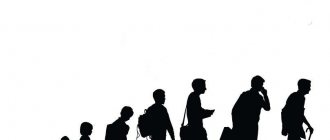Relationships in a team have a tremendous impact on the efficiency of the work process—every competent manager knows this. For many, work has long become a second home. That is why knowledge of the psychology of relationships in a team plays an important role.
Each employee is individual, has his own, sometimes difficult, character, preferences and wishes. Therefore, it is not surprising that conflicts and quarrels often occur within the team. How to avoid them and create an atmosphere of mutual understanding?
Social psychology of the team
The team at work is a social environment. It consists of many different people. They have different views on life, upbringing, goals for the future and abilities. However, they have to spend some time together and solve common issues. Interaction in this case is a direct path to the success of the company.
A person learns to find a common language with a team from early childhood. First comes kindergarten, then school, then university and, finally, work. And every time you have to adapt to new people. However, this is not always easy to do. As often happens in adulthood, people leave their jobs due to the fact that they do not fit into the team. And such cases are not uncommon.
The relationship between colleagues can be demonstrated with a clear example. Let's say a new employee comes to the company - a young and beautiful girl. What will those who have been working here for a long time experience at this moment? Most likely, there will be interest and, at the same time, tension. An employee can be compared to a foreign body that is at the stage of exploration by the body (in this case, the team). It is examined, studied and evaluated.
People will treat a new person differently. Some people will like the girl for her professional and personal qualities. For others it will irritate and irritate. In both the first and second cases, you will have to put up with the new employee, since relationships in the team as a whole and the activities of the company depend on coordinated work.
Team building program
The team is the core of society, in which public, group and individual interests are united; an organized community of people united by a certain type of activity and relationships, interests and norms of behavior that have developed in the course of this activity.
The principle of collectivism was one of the important principles of the socialist way of life. Socialism in the 70-80s of the 20th century was characterized by the formation of an integral system of collectives: labor, social policy, education, army, sports, culture, everyday life, etc. The central place in this system was occupied by labor collectives, through which more than 90% of the population of working age was involved in the processes of social labor.
In the 1990s, after the privatization of state-owned enterprises and the creation of a significant number of organizations with private ownership, real power in enterprises passed to owners and top-level managers. As a result, the influence of labor collectives and trade unions on the management of enterprises and the functions of public self-government itself was significantly weakened. Thus, over the past 20 years, public self-government and labor collectives have gone through two historical stages: Triumph and defeat.
The democratization of society and the market economy is an integral part of Russian society in the 21st century and will influence the formation of both social groups and work collectives.
In the process of their development, teams usually go through a number of successive stages.
- inclusion in .
At first glance, the new team seems businesslike and organized, but in reality people are looking at each other and trying to figure out how much they want to be involved in everything. True feelings are often hidden, one person exalts authority, and interactions occur in familiar ways. There is virtually no real discussion of goals and methods of work. People are often uninterested in their colleagues, barely listen to each other, and there is virtually no creative teamwork.
2nd "palace" draw.
Many teams go through a transition period where the leader's contributions are valued, clans and factions form, and disagreements are more openly voiced. Personal relationships become increasingly important and individual strengths and weaknesses emerge. The team begins to discuss how to reach an agreement and tries to improve relations. Sometimes there is a power struggle over management, which can lead to a change in leadership or the dissolution of the team. The leader must assert his authority or make room for a stronger leader.
- efficiency .
The team is growing in potential and is faced with the question of how to use the skills and resources it currently has. Often this team does not work regularly, but there is energy, interest and desire to understand how to work better. Working methods are being revised and there is a desire to experiment and take action to improve productivity.
- efficiency
The team gains experience in successfully solving problems and using resources. Emphasis is placed on proper time management and task clarification. Employees begin to take pride in being part of a “winning team.” Problems are viewed realistically and solved creatively. Leadership responsibility flows smoothly from one employee to another depending on the task at hand.
- skill.
In a developed team, strong bonds function between its members. People are accepted and valued on the basis of their merits, not on the basis of their rights. The relationship is informal, but satisfying. Personal differences are quickly resolved. The team develops into a thriving social unit and is admired by outsiders. He is capable of excellent work and sets high standards.
Psychology at work and team relationships
The branch of psychology that studies relationships in a team is rightfully considered the most difficult. And this is not surprising, because misunderstandings constantly arise between colleagues. There are several reasons for this state of affairs:
- doubts about the professional qualities of another person;
- setups in front of management;
- gossip and denunciations.
Similar problems happen in every team without exception. You can not only easily get rid of them, but also turn them to your advantage. This requires minimal knowledge of the psychology of communication and relationships with colleagues.
What is the task of management?
To adapt to a new society, every person, be it a boss or an employee, needs some time. This usually lasts about three months. Afterwards (the boss first), you need to show your best side and take decisive action. If this does not happen, people will not take him seriously or respect him. Modesty adorns leadership for some time.
It is easier for a new manager to notice shortcomings in a new place. When giving orders, he should not sit idly by. This will dramatically raise him in the eyes of his colleagues. The rules of behavior and communication in a team that has already formed dictate that the boss should not rush into everything and should not rush to change and establish his own “laws.”
The main task of a leader is to attract like-minded people, people who are ready to sacrifice anything to achieve a common goal. Such people can sometimes argue until they are hoarse, make mistakes, but still go towards their goals. And it is advisable to avoid people who look into the manager’s mouth and try in every possible way to please. As a rule, their actions are aimed at achieving their own upward mobility.
Types of relationships at work
Relationships with work colleagues vary. They are built according to three main schemes, each of which has its own characteristics, advantages and disadvantages.
Psychology of equal or friendly relationships
This is the closest communication. People praise each other, but will make reprimands if necessary. This type of relationship is not suitable for a manager and one of the employees. And there are reasons for this.
The friendship between the boss and one of the team members sets the latter apart from the rest. He occupies, so to speak, a privileged position, which others will definitely not like. This is a direct path to conflict.
Psychology of relations between elder and younger (from the position of the elder)
This type of relationship at work is divided into two subtypes:
- The mentor is the student. The first helps the second with advice, but does not guide him in any way, much less participate in his work. A student is unlikely to listen to advice if it comes directly from a boss who is poorly versed in work processes. A mentor gives you the opportunity to improve and move in the right direction.
- The leader is a subordinate. The boss evaluates the work of employees, controls it, and, if necessary, punishes or rewards it. Here we are not talking about close relationships, because they will destroy discipline in the team.
It is worth noting that the same person cannot be a leader and a mentor.
Psychology of the relationship between junior and senior (from the position of the junior)
Like the previous type of relationship, this one is divided into subtypes:
- The subordinate is the leader. The main task of the first is to take responsibility for his duties and follow the instructions of the second. He also needs to respect the leader, no matter what kind of leader he is.
- The student is the mentor. Relationships in a team of this type presuppose that the first one listens to the advice of the second. And he not only listens to them, but thinks about them and tries to put them into practice. If a student argues and refuses to listen to the work mentor, he is not ready to learn. In this case, all conversations are useless.
Each of the listed relationship development schemes makes it possible to build a healthy atmosphere in a team and establish communication.
Promotion
Career interests, of course, take first place at work. And the possibility of promoting one of your colleagues is not excluded. What if yesterday's partner became a leader? First of all, drive away thoughts of injustice and other negativity. Remember that a colleague's success does not necessarily mean your own failure. Perhaps a promotion awaits you soon. Direct your emotions in a productive direction: analyze your colleague’s business qualities and develop those that led him to success.
What if you yourself became the head of your department? This also imposes a number of restrictions. We will have to maintain subordination. However, this does not mean that warm informal relationships are impossible. You can still meet with yesterday's colleagues in a quiet cafe or discuss a new film during a break. Show respect to your new subordinates. Show that their opinion still matters.
A young manager must clearly understand the company's development strategy and strictly adhere to it. This will help in case of unpleasant decisions, or in case of disagreements with subordinates. Remember that personal friendships are one thing, but the interests of the company are another. And they should prevail in the workplace. Not everyone manages to maintain friendship if one of yesterday's colleagues becomes a manager. You need to be prepared for this: career growth always requires some sacrifices.
Editor's choice: Home business ideas for women: how to get promoted?
Rules of good manners
Relationships at work with colleagues should be built according to a few simple rules. The first concerns friendliness. You shouldn’t be rude or rude to others because you’re in a bad mood. Being polite and grateful isn't that hard. These qualities endear people.
However, caution must be exercised here, since close relationships in a team and informal communication can play a cruel joke. For example, a young employee will seem like a rival to women from the team. Men, because of her too free behavior, will consider her flighty and will lose all respect.
The second rule is a logical continuation of the first. You should not tell your work colleagues personal information about yourself. Good intentions and trust easily turn into gossip, speculation and envy. It is enough to tell the generally known minimum.
The third rule is similar to the expression “don’t run ahead of the locomotive.” Of course, it’s good if your abilities allow you to do the work quickly and at the same time with high quality. However, the team consists of different people. Some people work faster, while others, on the contrary, spend more time completing tasks. You should not try to correct or retrain your colleagues. They may take it as a challenge.
And finally, the fourth rule. It calls not to ignore the rituals and traditions of the collective. Joint dinners and holidays will only improve the relationship.
Behavior of people in an organization. Labor collective
Types of organizational behavior. Behavior is understood as a set of actions and actions of people occurring under the influence of internal and external reasons
Let's consider the main types of organizational behavior of people.
In terms of implementation, behavior can be work (official and unofficial) and interpersonal.
According to the subjects, it can be considered as individual or collective.
From the point of view of intentionality, behavior can be pre-planned and spontaneous, expressing a spontaneous reaction to certain events.
By function, behavior can be managerial and executive.
From the point of view of predetermination, we can talk about deterministic behavior, which implies submission to circumstances, and indeterministic behavior, depending on internal impulses.
Based on motivation, we can talk about value-oriented, oriented towards certain moral standards, and situational, depending on the prevailing circumstances and behavior. In the latter case, it can be compared to the behavior of a weather vane.
Based on the degree to which the interests of others (the organization) are taken into account, behavior can be considered as positive and negative. People don't always resist the negative behavior of others for fear of making the situation worse, of scaring them away, but this only makes things worse.
By nature, behavior can be passive or active. The latter, in turn, can be considered both aggressive and assertive.
From the point of view of direction, behavior can be constructive and destructive (illegal, individualistic, incompetent, etc.). The first type of behavior assumes that a person uses it to organize himself and his environment; the second generates disorganization and chaos. Moreover, they are inseparable. The only question that arises is which of them predominates at the moment and how purposeful the corresponding human actions are.
Based on the task of approaching the planned result, behavior is considered as rational or irrational (but in reality it is irrational in any case, for example, due to emotions, temperamental characteristics, etc.).
Depending on a person’s awareness of the factors that determine his actions and the degree of control over them, the following types of behavior are spoken of:
• reactive, involving automatic unconscious actions in response to changes in the external situation;
• instinctive, when the situation is realized, but actions are not controlled by the will;
• emotional, characterized by the fact that the situation is realized and, in principle, accessible to volitional control, but this does not follow due to the lack of desire of the subject;
• free, goal-oriented, in which a person is fully aware of the situation and controls behavior.
Behavior can be viewed in terms of the problems that people intend to solve with it. In accordance with this, the following types of behavior are distinguished:
• functional, determined by the requirements of technology and production organization;
• economic, associated with the desire to achieve certain benefits (maximum income - minimum effort; maximum income - maximum effort; minimum income - minimum effort);
• organizational, due to the reaction to the use of various types of management influence;
• adaptive, caused by the need to adapt to new working conditions and change one’s position;
• subordination, based on the requirements to obey the existing procedures, norms and rules in the organization;
• characterological, determined by personal characteristics.
In general, in an organization, a person can have three types of work behavior. Each of them is characterized by motives, understanding of necessity (feeling), will to it.
For some people, the required behavior is forced, externally imposed, which is due to a lack of understanding of its importance and necessity, and a lack of skills and habits. Under these conditions, the need to perform the functions of leadership or subordination is perceived as violence against the individual, an encroachment on freedom, causing internal protest, and sometimes even anger.
For others, this work behavior is internally desirable and brings a certain pleasure. For managers, this is associated with the opportunity to express themselves, demonstrate their own power, and get pleasure from this feeling. Subordinates are freed from the need to think and make independent decisions, which also makes life easier.
But under these conditions, the most active leadership and the most conscientious submission will not bring much effect, because the task of achieving a comfortable state is put in first place.
Finally, for still others, leadership and subordination represent a conscious necessity, including one arising from a sense of duty. In this case, their behavior is truly active, creative, effective and efficient.
The behavior of people in an organization is also influenced by: social role, social circle, peculiarities of perception of the environment, relationships in the team, and other factors.
The concept of social role. At work, as in the theater, people have to play certain roles. A social role is understood as a model of human behavior in the system of official and extra-official relations, corresponding to his place in the organization, official tasks, individual psychological characteristics, personal values (different people, having different values and ideas about the same role, behave differently in it ), as well as the expectations of others. An individual who does not live up to expectations is subject to sanctions from the latter, and those who justify them are subject to encouragement.
Employee roles may change from time to time, as well as their meaning (for example, in accordance with the stage of maturity of the team). Some of them require one person, but individual workers can fill several key roles, each of which is unique. Therefore, it is difficult to select performers for them, and in case of departure, to find a worthy replacement. The absence of a performer at a time of need is a serious problem for an organization, which can paralyze its work.
If the role is understandable and acceptable to the person and others, corresponds to his capabilities and desires, does not limit or humiliate him, it is performed with pleasure.
Otherwise, a person cannot fully realize himself and benefit the organization, which often gives rise to internal and external conflicts.
Experts identify several types of social roles that people can play in the process of work interactions. These include:
• coordinator. Possessing the greatest organizational abilities, regardless of his knowledge and experience, he supervises others, directing their activity to achieve their goals;
• the generator of ideas (as a rule, the most talented member of the team) develops options for solving the problems facing him, but due to passivity, lack of concentration, etc., is not able to implement them in practice;
• controller. Due to deep knowledge, experience, and erudition, he can properly evaluate any idea, identify its strengths and weaknesses, and outline ways for further work;
• the grinder has a broad view of the problem and therefore, if necessary, knows how to “link” its solution with other tasks;
• enthusiast - the most active member of the team, who, by his example, inspires others to take action to achieve the goal;
• benefit seeker - a mediator in internal and external relations, conflict resolution, giving a certain unity to the actions of team members;
• the performer implements other people's ideas, but at the same time needs constant guidance and encouragement;
• assistant - a person who does not personally strive for anything, is content with second-world roles, but is always ready to assist others in work and in life.
It is believed that the joint labor process will be carried out normally with the full distribution and conscientious performance of the listed roles. If someone has to simultaneously take on two or more roles (or some role is left without a “performer”), conflicts usually arise.
Interpersonal roles are typically divided into leaders and followers. The first ones are played by the so-called preferred persons (“stars”, authoritative, ambitious), who are somehow attractive to others. The second are all the others, including non-preferred ones, with whom they cooperate only by force (often they are made bearers of collective guilt).
Circle of friends. A person works, interacting with other people - colleagues, managers, subordinates. As a result, he is included in a certain system of interpersonal relationships, which is called the circle of communication. The influence of the social circle is especially strong on the leader, who, when making a decision, cannot help but take into account his opinion. It can be official, predetermined by official connections, and personal, based on emotional relationships.
In practice, the circle of closest contacts, which includes especially trusted persons (usually no more than 4-5 people), is distinguished first of all. The subject has a close emotional connection with them and the ability to discuss and solve any problems without fear of information leakage.
Only official issues are regularly discussed with people included in the circle of constant or periodic communication. Usually it includes the manager, all direct subordinates and some colleagues with whom official interaction is carried out.
The circle of episodic communication includes all colleagues, as well as persons outside the organization.
Each of these circles has its own ethics and norms of behavior that cannot be violated. Otherwise, the person will be subject to public condemnation.
When moving to another social circle, for example, in connection with a promotion, when previous relationships are partially destroyed or depreciated, and new ones have not yet developed, a person temporarily finds himself in a certain vacuum. Random people, including selfish ones, who want to establish themselves under the “new government” as quickly as possible can rush into it, especially when it comes to a leader.
Therefore, in a new place, you should not get close to someone in the very first days; it is better to first carefully, slowly, take a closer look at others. This is important, since successful mastery of the predecessor’s social circle is one of the most important prerequisites for successful adaptation in a new environment.
Relationships between people in an organization. People’s positive perception of each other leads to the formation of first an elementary emotional disposition (a positive attitude towards someone or something, and then trust - a stable disposition based on a high individual assessment.
Disposition towards people is manifested in respect, readiness to help in difficult times; disposition to work - in passion for it, to the point of identifying oneself with one’s work and sacrificing one’s other interests to it.
The emergence of trust is due to the coincidence of basic life interests, goals and values (people, of course, sympathize with those who share their views and positions, are nearby, participate together in work activities, but it is unlikely that anyone will have good feelings towards competitors), common manner of behavior.
Based on trust, preferences are formed (primary mutual preferences of individuals are called sentiments), reflecting the desire to cooperate with a given subject, and then permanent relationships.
Relationships vary:
• by orientation (towards people, oneself, work, society);
• by nature - emotional and conscious (rational and irrational);
• by the number of subjects - bilateral and multilateral (bilateral relations are already a special case of the group);
• according to the orientation of the assessments - positive and negative;
• in terms of content - functional and personal.
Functional relationships exist between positions and are associated with decision making, setting tasks, etc. They are initially official and rational, aimed at obtaining real benefits. Personal aspects here can either help or hinder their implementation.
Personal relationships are personalized and arise between specific people. Unlike official ones, they are less stable, since they are based primarily on emotions and experiences.
Depending on the situation, such relationships can be conflictual (with dominance of one side), harmonious (cooperation, mutual assistance) or neutral, combining both.
Relationships are a kind of prism through which everything is perceived - people, events, activities. It is clear that if they are imposed “from above” through coercion, they can generate antipathy. In this case, the interaction between people in the process of doing work will be ineffective, and their behavior will be negative.
The concept of “I-states” by E. Berne. Many aspects of the behavior of subjects, including business, are explained by the concept of “I-states” by the Swiss psychologist E. Bern, developed in the 1960s.
“I-state” is a system of feelings, a set of coordinated behavioral patterns. It is determined by the general mood of people and the conscious choice of a model of behavior pursuing a specific goal.
E. Berne argues that a person is constantly in one of three psychological “I-states”: “parent”, “adult” and “child” with varying degrees of readiness to move into another.
Each of the conditions has its own specifics.
The parent's state is externally expressed in an ironic manner; teachings; attempts to ban and punish everything; searching for the culprits; claims to be right; preoccupation with everyone and everything; desire to support, help, console, patronize. The parent can be expressed directly (“Do what I say”) or indirectly in relation to demands.
The state of an adult is characterized by activity, a sober approach to business, taking into account the real state of affairs, and the use of experience. He is characterized by efficiency, the search for alternatives, and dispassion.
In the state of a child, people act and feel as they did in childhood - unpredictably, playfully, capriciously, capriciously, obstinately, etc. In immature people, the behavior is controlled by the child, in mature people - by the adult.
Interaction between people (“transaction” according to E. Bern), in whatever form it occurs, is always determined by the states (natural or artificial) in which they are currently located.
There are three transaction options, three interaction styles, which each person can use alternately for a short time.
• parallel, when the participants in communication are in the same “I-state”. It can continue indefinitely because people understand each other perfectly and respond and behave accordingly;
• Cross assumes that the interlocutors are in different “I-states” and play different roles. As a result, they, trying to convince that they are right, do not understand each other (or create the appearance of this), which leads to a breakdown in communications;
• hidden, encountered at every step and manifested as reticence, allegory, criticism with subtext, a “double bottom.” Outwardly, it seems ordinary (parallel or cross) and is camouflaged as a conversation that means nothing or means something completely different.
Having achieved inertia in him, the initiator abruptly changes his “I-state”, stuns the opponent, confuses him, which makes it easier to impose his demand. Such actions are called a game, which begins with a trick (psychological bait), and touches the other person’s vulnerable spot so that he must acutely feel it.
Games are often destructive (searching for those to blame instead of analyzing situations, avoiding unpleasant and difficult decisions, saving oneself under the guise of helping others, etc.). It is permissible to use them in positive situations of good-natured jokes, but criticism should be open.
Since games are inherently manipulative and lead to intense passions, they should be avoided. Once the game has started, behave firmly and consistently. At the same time, it is recommended to react to the situation not from the “I-state” imposed by the partner, but from the “adult” state; ignore the hidden level of communication or specifically address the hidden part (“our sheep”) when the other side evades direct answers.
The concept and characteristics of the work collective. Today people do not work alone, but as part of a group, always acting in relation to other groups as a single whole.
In an organization, a group can exist as a division, project team, committee, team, etc., while acting as a managerial, managed or self-governing structure.
In accordance with the degree of cohesion of participants, several types of groups are distinguished: group - conglomerate; association group (flock); group-collective. There are six characteristics of a team.
Types of teams. The composition of teams can be homogeneous or heterogeneous. Based on their status, groups can be either official or unofficial. By the nature of internal connections - formal and informal. Based on the duration of their existence, teams can be temporary or permanent. Based on size, teams are divided into small and large.
A team is a type of collective. A special type of team is a team that is created to solve the most complex problems - perform special functions, develop important projects, promote creativity. Classification of commands. What characterizes a team? What is the difference between a team and an ordinary work collective?
Psychological characteristics of the team. Collectives differ from each other psychologically, which is manifested in the nature of their internal climate, the state and degree of cohesion of the participants. The psychological climate reflects the state of internal relationships in the team. The psychological state is determined by the degree to which people are satisfied with their position. Team cohesion. Conditions of socio-psychological compatibility.
Team development process. A cohesive, efficient team does not appear immediately. This is preceded by a long process of its formation and development, the success of which is determined by a number of circumstances that have little to do with whether the team takes shape spontaneously or is formed purposefully. Both forced and spontaneous formation of a team leads to this. That its composition and structure turn out to be suboptimal. Internal relationships in a team are identified using sociographic methods. The official team goes through a long process of organization, consisting of several stages. Team consolidation.
Conformism and its role in team management. The strength of a team is largely due to the conformity of its members. This is a psychological feature of people’s behavior, manifested as group like-mindedness and refusal to act independently. Reasons for conformity. Degree of conformity Positive aspects of conformism. Types of human behavior from the point of view of attitudes towards norms.
Lecture No. 11
First day: fatal success
Relationships in a team at work largely depend on the first impression of an employee. He will have to pass a kind of test, the results of which will be the basis for his further communication with colleagues.
So, on your first day of work you need to follow a number of simple recommendations:
- Dress as modestly as possible, even if in real life your clothing style can hardly be called modest.
- Don't forget about the rules of etiquette. The minimum is a greeting and words of farewell.
- Do not flirt with male representatives. This will only ruin relationships with them and with women.
- Don't argue trying to prove you're right.
- Don't reveal too much about yourself.
- If necessary, ask colleagues for help.
It is not difficult to follow these tips. It's enough to just relax and try to enjoy your work.
We are so different and yet we are together
Building healthy relationships at work isn't easy. This is due to the fact that each person is individual. There are several types of employees:
- Angry or grumpy. Unfriendly people who are always dissatisfied with something and easily lose their temper. For them, every word or reaction of others is an opportunity to throw out negativity. Such people have no desire to talk about good things.
- Envious people. The favorite pastime of such team members is spreading gossip, both at work and outside of it. They discuss everything from new lipstick to professional activities. These people are simply bored. When communicating with them, you need to avoid talking too openly about yourself and your family.
- Rigid colleagues. They don't like change. Even if the new one is many times better than the old one, they will not change anything. Relations with such employees should be based on strict adherence to established rules and instructions.
- Advisers. They constantly teach those around them, giving out advice left and right. They are harmless. The worst thing that their behavior leads to is a quarrel at work. When communicating with colleagues of this type, you need to take the initiative and ask for advice first.
- Pedants. React to the slightest inaccuracies and details. It is quite easy to moderate their ardor. It is enough to shift some of the responsibilities that require great attention and scrupulousness.
- Artists. They love to be the center of attention. Scandals at work are a way for them to recharge their energy. A couple of compliments and attention will turn them from enemies into allies.
These are just a few types of employees. In fact, there are many more of them. And if you can’t find a way to build relationships with them, you also need to pay attention to yourself. Perhaps the problem lies in your character and actions
Why relationships with colleagues can deteriorate
- a timid, withdrawn person pushes away and does not evoke a desire to get closer to him. You shouldn’t allow yourself to be ridden, but shamelessly taking advantage of someone else’s kindness is also impolite. Follow the golden rule: I help, they help me;
- Reporting to employees and the desire to drag management into a scandal with colleagues will not elevate a person in the eyes of the team. Clarify your relationship in private, face to face;
- sometimes irritation and failures in business overflow. In order to calm down and not commit an act that you will later regret, there are many different psychological trainings;
- directness is not always a noble trait. Before speaking sharply, you should think carefully about where, what and to whom to say;
- Relationships at work should remain formal, purely business. The manager will also be very dissatisfied with frequent absences and long conversations with other colleagues;
- in an emergency situation, when all employees are overwhelmed with urgent work, do not sit idle, work equally with everyone else;
- Don’t bother your colleagues with stories about how well-coordinated your previous work was; you may hurt their feelings;
- You won’t get a pat on the head for stupid, out-of-place curiosity;
- I've probably had to deal with a lot of ill-mannered people who don't follow the rules of etiquette. These people think only about themselves. They irritate with a strong perfume, loud laughter or conversation, obscene expressions, a song screaming from the phone, and so on. A very unpleasant impression remains after meeting such individuals;
- excessive zeal for work, otherwise called workaholism, can make colleagues suspicious of your desire to get closer to your superiors, of your desire to be promoted;
- fear of communication and uncertainty. Well, with such people everything is clear, they try not to notice them.
What can provoke colleagues into conflicts?
According to psychology books, healthy relationships in a team are sometimes threatened. There are many reasons for this:
- unsociability, reluctance to make contact;
- complaints and denunciations against colleagues;
- bad mood spilling out on others;
- excessive self-confidence and straightforwardness;
- fear of overworking;
- comparison of former work with current one;
- excessive curiosity towards colleagues;
- loud conversations on the phone, elevated tone when communicating with others, strong aroma of perfume.
Another reason for a possible conflict lies in workaholism. Sometimes the desire to do quality work is perceived from the outside as a desire to curry favor with management or stand out from the crowd.
The task of the authorities
What is the task facing the boss? Any leader, knowing the basic rules of behavior in a team, must first of all be demanding of himself and set an example for his subordinates. He needs to clearly and competently set tasks for his subordinates, and also explain what the result should be. If a junior colleague copes with the task without comments and on time, then the manager needs to encourage the employee. Moreover, the more merit, the greater the reward.
If a subordinate fails to complete the intended task, then when criticizing him, one should not become personal. Reasonable criticism should concern only business matters and should not interfere with the personal life of an employee.
The boss faces another task - protecting his employees from their superiors. He needs, if possible, to protect his subordinates both from the company’s management and from outside attacks.
Relationships in a men's team: let's set priorities
In a male team, as well as in a female team, conflicts often occur. There are several ways to prevent them:
- Always look perfect. The best clothes for work are a formal business suit.
- Extra attention from colleagues or even flirtatiousness surprises and baffles. There is no need to be rude in response. It is better to remain silent or move the conversation to another topic.
- It is worth remembering that each member of the team is an employee like everyone else. Therefore, demanding special treatment for yourself is not nice.
- Do not react to provocations too emotionally. It is important to remain calm even in cases where emotions are brought out on purpose. This requires resilience.
The most important thing is to show respect to all colleagues at work without exception. We can say that this is the key to a good relationship.
Bullying: one on one
When the boss of Maya, who worked as an assistant judge, was hospitalized for a whole year due to a serious illness, his employees were temporarily transferred to another site. There the woman had to deal with the inappropriate behavior of one of her colleagues. “She worked as an assistant to my new manager and for some reason immediately took a dislike to me and played dirty tricks with terrible force. Then rumors will spread behind my back that I allegedly got the job through bed. She kept silent about the boss’s important request, but she herself blatantly lied to him that she told me everything,” Maya shares.
This is another version of psychological terror - bullying (bully), or the persecution by one person of another, usually of equal status. It is believed that a feature of bullers is a constant thirst for “fresh blood”. Often after the victim, unable to withstand the bullying, quits, the attacker takes over for the next “lamb.”
How to build relationships after a conflict: advice from a psychologist
Knowledge of the psychology of relationships in a team at work does not guarantee the complete absence of conflicts. What to do if it happened?
- Calm down, relax. Focus your thoughts on the good qualities of the provocateur or offender. This will help, if not forget the situation, then at least restore good relations.
- Look at the controversial situation from the outside. Thanks to this, you can control yourself, preventing your opponent from disturbing the balance and thereby achieving what you want.
You can only disarm a person who plans to continue the conflict with calm and balance. These qualities, together with a sober look, make it possible to destroy all the intentions of the offender.
So, what are the relationships in a team like? Usually complex, since each person is a formed personality. Everyone has their own views on life and what is happening around them. The team includes advisers, provocateurs, envious people, pedants and even artists. If you find an individual approach to each of them, the relationship will become harmonious and healthy.
Which team is considered cohesive?
- When all employees have common goals. For example, increase sales to a million per month, or bring the site to the top 10 positions in Yandex. These goals must be conveyed to every employee - let people know what they are trying to achieve.
- When an online store has a mission and values that are shared by all employees. Exactly EVERYTHING - without exception. If there is an indifferent person in the office who puts a screw on all your valuables, he will be able to cool down the entire team.
- When the team has people of similar character. It is clear that the main thing is work, but we also must not forget about a good psychological climate. It’s trite but true: people should be comfortable together. Only then will they be able to work effectively and complete the tasks you set.
- When the manager really manages the team, and does not blame everything on the deputy or employees. Yes, yes, the unity of the team ultimately depends on you.
- When employees unite together against some enemy - real or abstract. Usually this is a competing company, but it can also be an individual employee - a scapegoat, or even a customer who is annoying to everyone. In extreme cases, employees unite against the manager. It’s sad to hear this, but the fact is a fact: the common struggle brings us together and gives us that very sense of cohesion that we are talking about. Try not to let it be directed against you!
Components of a cohesive team










